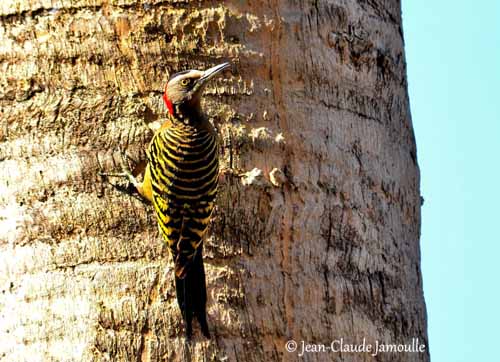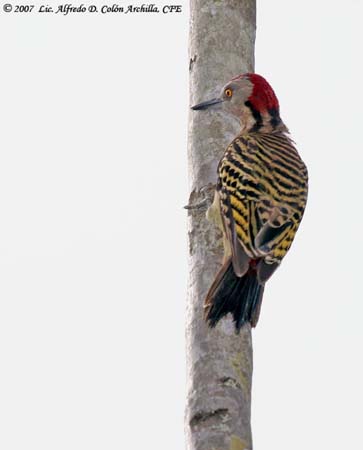
Fr: Pic d’Hispaniola
All : Haitispecht
Esp : Carpintero, Carpintero de la Española, Carpintero Dominicano
Ital : Picchio di Hispaniola
Nd: Hispaniolaspecht
Sd: Haitispett
Photographers:
Alfredo Colón
Puerto Rico Wildlife
Jean Michel Fenerole
Photos d’Oiseaux du monde
Jean-Claude Jamoulle
A la rencontre des Oiseaux
Text by Nicole Bouglouan
Sources:
HANDBOOK OF THE BIRDS OF THE WORLD Vol. 7 by Josep del Hoyo-Andrew Elliott-Jordi Sargatal – Lynx Edicions – ISBN: 8487334377
BIRDS OF PUNTA CANA – Dominican Republic – by David Rosane and Eloy Rodriguez - The Carriage House Press – 2002 – ISBN: 0971974500
BirdLife International (BirdLife International)
AMNH DSpace Digital Repository - American Museum of Natural History
CREAGUS@Monterey Bay (Don Roberson)
Hispaniolan Woodpecker
Melanerpes Striatus
Piciforme Order – Picidae Family
INTRODUCTION:
The Hispaniolan Woodpecker is endemic to Hispaniola Island in the Caribbean. This species is common and conspicuous in its range. They live in social groups which spend the day moving acrobatically through gardens and forests.
They are very agile when clinging to vertical trunks or hanging upside down from branches. They are particularly common in palm groves, flying around from tree to tree and hammering at the palm’s wood all day long.
DESCRIPTION OF THE BIRD:
Biometrics:
Length: 20-24 cm
Weight: M: 83-92 g – F: 65-75 g
The adult has black upperparts and tertials broadly barred greenish-yellow to golden. The upper rump is yellow to greenish-yellow, with red-tipped feathers on the lower rump, often faintly barred blackish. The uppertail-coverts are red with black bases. Primaries and secondaries are brownish-black with broad yellowish bars, but whiter on primaries. The tail is brownish-black too, with whitish-edged outer rectrices. The tail feathers are very stiff, helping the bird when clinging on tree-trunks.
The underparts are dark reddish-buff with grey wash, whereas upperbreast and belly are tinged olive. There are sometimes some red-tipped feathers on belly, and occasionally darker streaks on lower flanks. The underwing is barred brown and white, whereas wing-coverts are olive-green. The undertail is brownish with yellow wash on outer rectrices.
On the head, the male has bright red forecrown to upper hindneck. The red feathers have black bases. Rest of head, including forehead and superciliary area, is pale buffy-white to greyish. The ear-coverts may appear greyer. Chin and throat are mostly olive-buff. The lower hindneck is broadly and vertically striped black and whitish.
The long, straight, broad bill is dark grey with darker tip. The eyes are white to pale yellow. Legs and feet are greenish-grey. Feet are large and equipped with sharp claws.

The female has similar plumage except on the head where the crown is black instead of red. Her bill is up to 20% shorter than that of male.
The juvenile resembles adult but it has more orange nape and uppertail-coverts. Young of both sexes show white-spotted black crown with few red tips.
RANGE:
The Hispaniolan Woodpecker is restricted to the Dominican Republic and Haiti. This species is endemic to the Island of Hispaniola in the Caribbean. It is resident in its range.
HABITAT:
The Hispaniolan Woodpecker is particularly common in palm groves, but it also frequents wooded swamps, coastal scrub, semi-arid country in lowlands and humid pine forest in mountains.
It can be seen in and around villages and towns, in city gardens.
However, they are numerous in cultivated areas interspersed with woodlands in hilly areas, where crops are associated with palm trees. This species is considered a pest by farmers because they damage the crops.
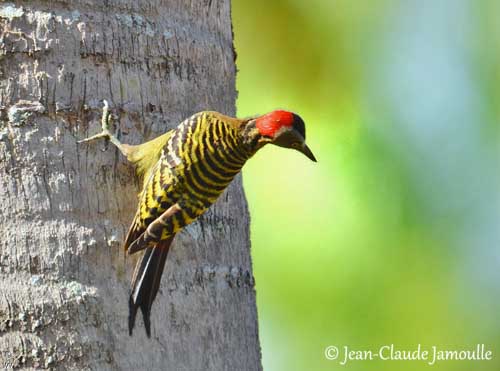
CALLS AND SONGS: SOUNDS BY XENO-CANTO
The Hispaniolan Woodpecker gives long series of more than 20 notes to communicate over long distance. During encounters, they utter several “waa” notes, aggressive “wup”, and more defensive “ta-a” calls. We can also hear 3-5 distinct notes, giving a short “bdddt” call.
Near the cavity, drumming is used as signal.
BEHAVIOUR IN THE WILD:
The Hispaniolan Woodpecker feeds mainly on insects of numerous species such as beetles, Lepidoptera, ants (adults and pupae). It also takes spiders, scorpions and lizards. Fruits, berries, nuts, seeds and tree sap are readily taken.
It feeds mainly by pecking, probing and gleaning, and insects are caught by hawking.
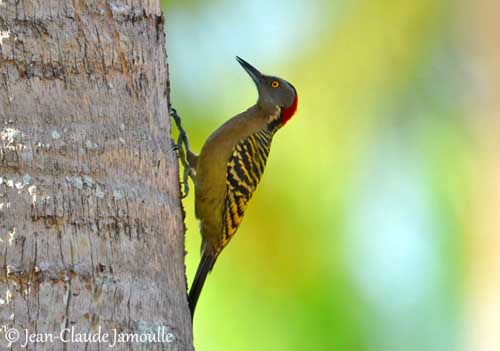
The Hispaniolan Woodpecker, like all woodpeckers, has ingenious food-finding instruments. It usually probes in crevices and holes, often in dead substrates and tree’s bark, in search of invertebrates, often wood-boring insects and larvae. If some prey is discovered hidden beneath, it uses its strong bill to open the wood. Then, the prey is impaled with the long, extendible, arrow-headed tongue, protruded as much as 15 centimetres out of the bill. The well adapted tongue’s tip is covered on both sides by backwards-pointing barbs, and allows the bird to scour out ants and other insects. The larger items are usually placed in anvil for treatment before to be swallowed.
The Hispaniolan Woodpecker forages at all levels, usually between 7 and 20 metres on trees, bushes, vines, poles or cacti. It is often seen hanging upside-down on small branches and pine cones, in order to reach a fruit.
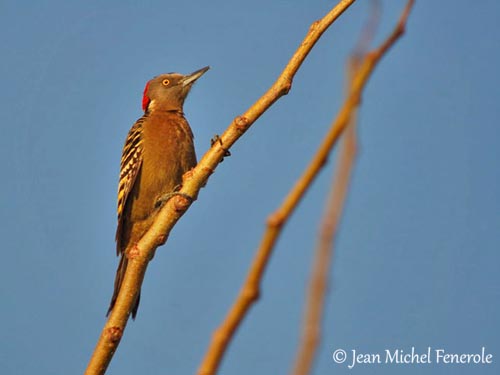
During the breeding season, the Hispaniolan Woodpecker performs displays, as well courtship as defence displays. Aggressive encounters may occur at the beginning of the season and around the egg-laying period, involving more vocalizations, wing-flicking, head and body swinging and tail spreading. They also perform bowing movements accompanied by loud calls.
During these displays, the bright red feathers of the head are erected, the head is extended and the bill pointed forwards at the opponent. However, defence and courtship displays are often similar.
During courtship, the male performs aerial displays, a flutter-aerial display including a gliding flight with wings held above the back, accompanied by drawn-out, squeaky calls. Mate-feeding has been reported for this species too.
The Hispaniolan Woodpecker may nest solitary or in loose colonies of 3-20 pairs. This species sometimes engages in communal nesting activity with several helpers. Within the colony, several holes, up to 26, can be found in a single tree. Usually, the highest cavity is occupied by dominant birds. Drumming occurs from time to time near the nest-site, and the pair defends a variable area near the hole.
They excavate the hole, even large cavities in tree trunks, thanks to their powerful bill. They can chisel or pierce through soft wood when carving out their cavities.
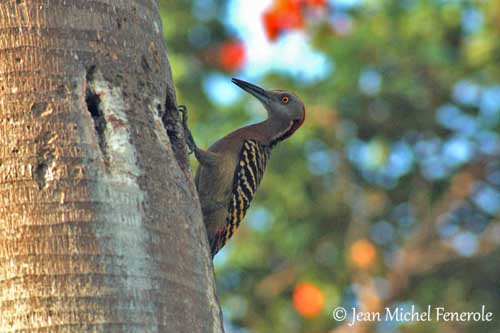
The Hispaniolan Woodpecker has an undulating flight like all woodpeckers. It also performs beautiful aerial displays with great agility.
It is resident in its range.
REPRODUCTION OF THIS SPECIES:
The Hispaniolan Woodpecker can breed all year round, but mainly between February and July. It may nest solitary or in loose colonies of 3-20 pairs, with several nests in a single tree. But usually, a colony occupies 1-3 trees.
This species may have helpers during the nesting period.
Both sexes excavate the nest-hole, but the male more than the female which has shorter bill. The hole is situated between 2 and 11 metres in dead tree, live or dead palm, cactus or telephone pole. The entrance is 9-7 centimetres high and 7-9 wide. They defend the nest-site and the nearby prominent perches.
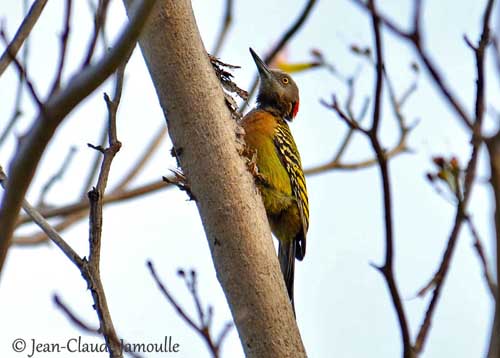
The female lays 4-6 white eggs. The incubation period is currently not documented, but usually, woodpeckers have short incubation periods, from 9 to 14 days. Both parents share the incubation duties.
The chicks are fed by regurgitation. The adults deliver the food to the chicks in the tip of the bill. From several observations, one fed occurs every 6-8 minutes. Once fledged, the young are fed by parents near the nest and during several days.
PROTECTION / THREATS / STATUS:
The Hispaniolan Woodpecker lives in restricted range where it is common and widespread. But this species could be threatened by degradation and habitat loss, and increasing human developments.
The species is considered a pest by farmers because they damage commercial crops, and this woodpecker is sometimes persecuted locally.
But currently, the Hispaniolan Woodpecker is not threatened.
